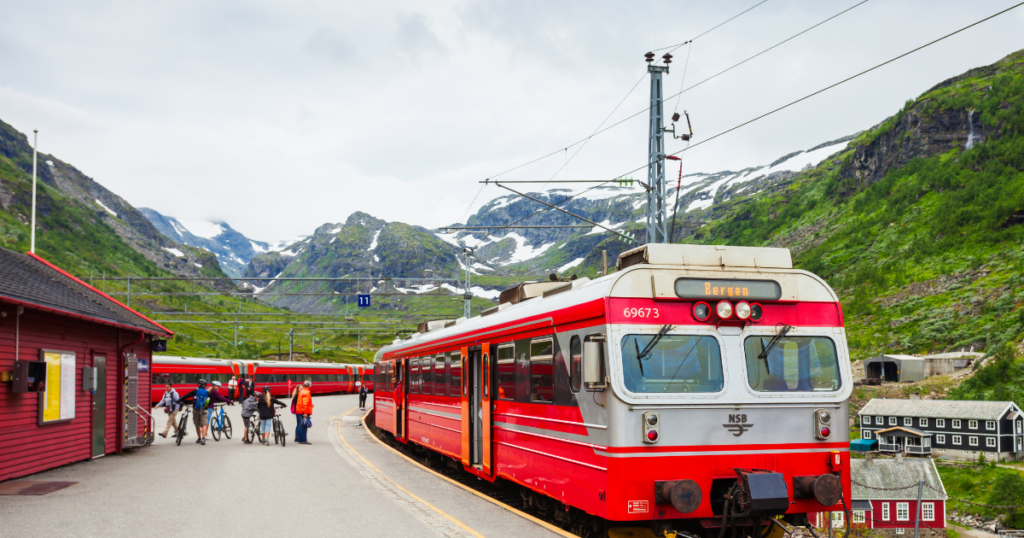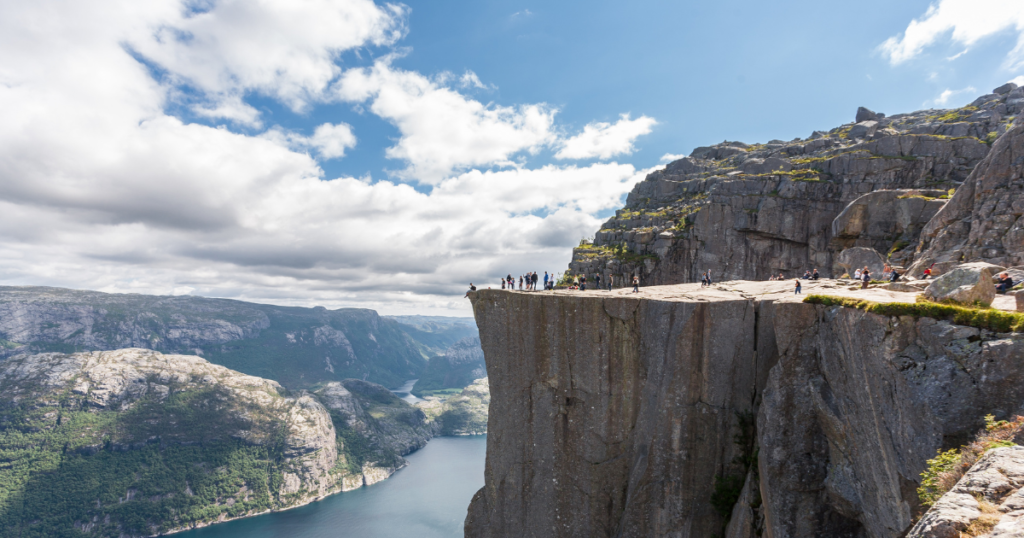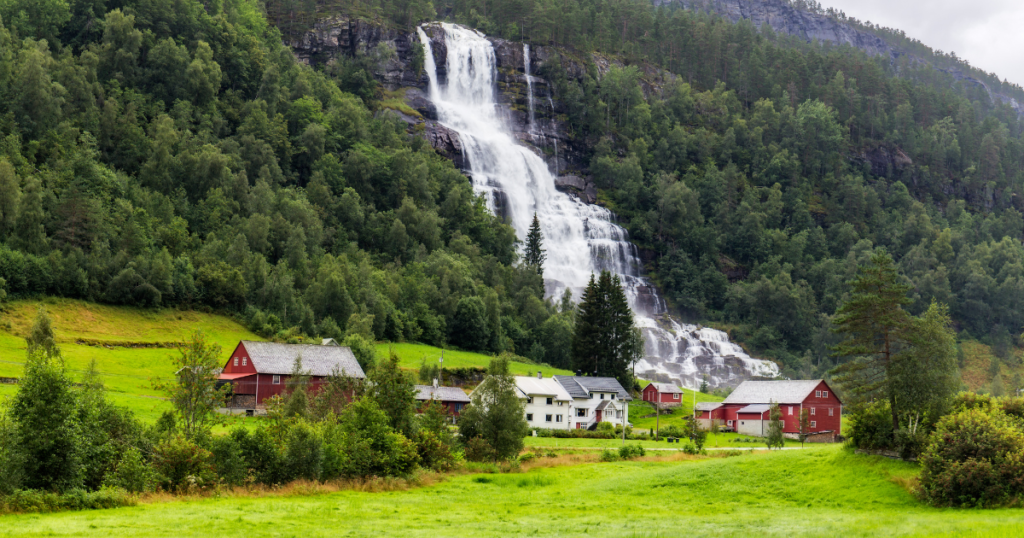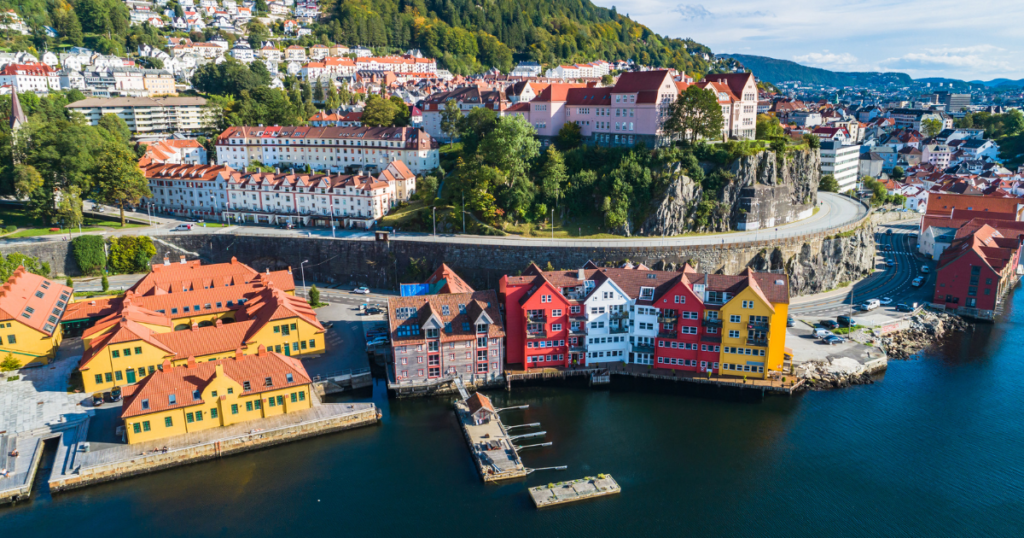Discover how to travel Norway Fjords without a car! This complete 7-day itinerary shows you the best train, ferry & bus routes, hidden gems, budgets & local tips for 2025.
Introduction
When I first moved to Norway, I thought renting a car was the only way to see the fjords. Every blog seemed to insist that driving was essential. But after a few years of living here, I realized something most travelers don’t know: you can explore Norway’s breathtaking fjords entirely by public transportation—and sometimes the train window offers better views than a car ever could.
Norway’s transport network is among the most scenic and efficient in the world. Trains climb mountains, buses snake through valleys, and ferries glide quietly across mirror-like fjords. With a little planning, you can visit world-famous spots such as Flåm, Nærøyfjord, and Bergen—without ever turning a key in an ignition.
This 7-day itinerary combines travel routes, cost breakdowns, and family-tested tips to help you experience Norway’s natural beauty car-free, stress-free, and on budget.
🚗 Why You Don’t Need a Car in Norway
Driving is gorgeous but pricey. Rental cars can cost €100–€150 per day, plus additional fees for tolls, parking, and fuel. Parking in cities like Bergen or Oslo can easily reach €40 a day, and winter driving requires snow-ready tires and mountain experience.
Norway’s trains, buses, and ferries, however, connect even small fjord villages.
But of course, I cannot deny that we love cars for our own comfort, especially when we need to transport something or buy a week’s groceries; in such cases, we prefer to use cars. But when we are talking about exploring Norway, public transport has so much to offer.
Here’s what makes car-free travel so easy:
- Integrated national system. The website Entur.no and its app combine every mode of transport—train, bus, metro, ferry—into one searchable platform. Alternatively, if you are visiting mainly Oslo and Akershus, then the app ruter.no is convenient for use.
- Scenic design. Train windows are panoramic, buses stop at photo points, and ferries feel like cruises.
- Reliability. Everything runs on time (almost obsessively so). If one service is delayed, another is usually held so you don’t miss your connection.
- Environmental bonus. Norwegians are proud of sustainable travel. Going car-free aligns perfectly with local values.
💡 Pro tip: Buy your tickets early. Fares on Vy.no are dynamic—the earlier you book, the cheaper it gets.
💰 Travelling Norway Fjords on a Budget
Norway has a reputation for being expensive, but smart travelers know where to save.
| Expense | Average per day (€) | Tips |
|---|---|---|
| Accommodation | 60–100 | Book cabins (hytter) or Airbnbs with kitchens |
| Food | 25–40 | Grocery shops: Rema 1000, Kiwi, Extra |
| Transport | 30–50 | Advance tickets on Vy or Skyss apps |
| Activities | 20–40 | Hiking & nature are free |
| Total | ≈120–150/day | Manageable even for families |
Money-saving tips
- Grocery shop-once and cook dinners; even hostels provide kitchens.
- Refill bottles—tap water is glacier-fresh.
- Travel in shoulder seasons (May–June or Sept–Oct).
- Use Bergen Card or Oslo Pass for free transport + museum entry.
🗺️ How to Travel Norway Fjords Without a Car:
7-Day Norway Fjord Itinerary
This itinerary follows the classic Oslo–Bergen rail corridor and the UNESCO-protected fjords in between. Each leg relies only on public transport.
🏙️ Day 1 – Arrive in Oslo: Norway’s Cultural Gateway
- Arrive: Oslo Gardermoen Airport. Take the Flytoget express train (20 min) to Oslo S. Or take the regional trains, which are cheaper than the Flytoget
- Morning: Walk the roof of the Oslo Opera House—You will get a 360
- Morning: Walk the roof of the Oslo Opera House—You will get a 360° view of Oslo Centrum.
- Afternoon: Explore Aker Brygge waterfront and Akershus Fortress, and don’t forget to check Vigelandsparken (Vigelands Park)
- Evening: Explore Oslo Street Food, where international cuisine meets in one place!
- Where to stay: Citybox Oslo — modern, central, around €80 a night.
Check this One Day Oslo City Tour Guide Blog.
💡 Insider note: Sunday evenings are quiet; plan grocery shopping on weekdays or Saturdays because shops are closed on Sundays. Small boutiques are open though, but it’s more expensive.
🚆 Day 2 – Oslo → Myrdal → Flåm (Train & Scenic Railway)
- Route: Bergen Line (Oslo–Myrdal 5 h) → Flåm Railway (1 h).
- Highlights: Hardangervidda Plateau, alpine lakes, countless tunnels.
- Don’t miss: Kjosfossen Waterfall—train stops so you can step out for photos.
- Arrive Flåm: Nestled between steep cliffs and glassy fjord water.
Stay: Flåm Camping & Hostel (€70–90) or Flåm Fjord Lodge (cosy cabins).
Eat: Try Ægir BrewPub for local salmon burger & craft beer.
💡 Reserve both train legs together on Vy.no to guarantee connection.
⛴️ Day 3 – Flåm → Gudvangen (Fjord Cruise) → Voss
Morning: board the Nærøyfjord Cruise—part of the Norway in a Nutshell route.
The 2-hour journey through Aurlandsfjord and Nærøyfjord is jaw-dropping: waterfalls plunge from 800 m cliffs.
- Book: visitflam.com or on site (summer = crowded).
- Arrive: Gudvangen — a Viking-style village with souvenir huts.
Afternoon: take Skyss bus 950 to Voss (1 h).
Evening: stroll around Lake Vangsvatnet—locals swim here in summer.
Stay: Voss Vandrarheim Hostel — €80 double, breakfast included.
💡 Budget tip: Buy combination ticket “Fjord Cruise + Bus to Voss” to save about 20 %.
🏞️ Day 4 – Voss → Bergen (Train)
- Duration: 1 h 20 min.
- Arrive: Bergen—the colorful Hanseatic port known as the gateway to the fjords.
- Must-see: Bryggen Wharf (UNESCO heritage), Mount Fløyen Funicular, and Fisketorget Seafood Market.
- Local life: Take a sunset walk along Nordnes Park; kids love the small outdoor pools.
Stay: Marken Guesthouse or Budget Hotel Citybox Bergen (€90–120).
💡 Saver tip: Buy a 24 h Bergen Card (≈€40) for free buses + museum entries.

🍎 Day 5 – Day Trip to Hardangerfjord (Waterfalls & Fruit Farms)
- Route: Bergen → Norheimsund → Øystese → Odda (bus 925).
- Why go: Hardangerfjord is less touristy yet filled with dramatic landscapes.
- Stops:
- Steinsdalsfossen Waterfall — walk behind the waterfall curtain.
- Hardanger Cider Farm — sample apple cider or juice (Apr–Oct).
- Odda — base for the famous Trolltunga hike (if you have extra days).
Return: Evening bus to Bergen.
💡 If travelling with kids, pick a mini-cruise from Norheimsund; two hours is the perfect attention span!
⚓ Day 6 – Optional Extension to Stavanger (Pulpit Rock)
If you still have energy, extend to Stavanger, a southern fjord city.
- Transport: Fjord Line ferry Bergen → Stavanger (5 h coastal journey).
- What to do: Climb Preikestolen (Pulpit Rock)—a total of 4-5h hike to a flat cliff 604 m above Lysefjord. This is not an easy hike; consider your physical being and fear of heights before doing the climb to the Pulpit Rock.
- Stay: Comfort Hotel Square (€100 per night).
- Eat: There are pizzerias to choose from, as well as seafood restaurants in the area.
💡 Families with young kids can instead visit the Norwegian Petroleum Museum—interactive and rain-proof!

🏔️ Day 7 – Return to Oslo or Extend North
- Return option: Vy train Stavanger/Bergen → Oslo (6–7 h) or flight (50 min).
- Extension option: Fly to Ålesund or Tromsø for Northern Lights or midnight sun.
Before you leave, buy some Brunost (brown cheese) or Kvikklunsj bars — the tastes of Norwegian adventure.
🧭 Bonus Section – Practical Tips for Car-Free Travel
- Download the Entur App. It integrates every route in English, showing real-time delays and platform numbers.
- Travel light. You’ll carry bags on ferries—pack a backpack + small rolling case (max 15 kg ideal).
- Bring a thermos. Hot coffee on a cold fjord deck is pure joy.
- Layer up. Fjord winds are chilly even in August.
- Sunday planning. Transport runs less frequently; check timetables a day before.
- Credit cards everywhere. Cash is rarely used; even toilets take Visa!
- Wi-Fi on trains. Free and strong enough to stream Netflix for kids.
🏡 Accommodation Suggestions (With Views + Value)
| Location | Hotel/Hostel | Average €/night | Why stay |
|---|---|---|---|
| Oslo | Citybox Oslo | 80–100 | Steps from the station; great for the first night |
| Flåm | Flåm Fjord Lodge | 90–120 | Cabins with fjord views + kitchenettes |
| Voss | Voss Vandrarheim | 70–90 | Free breakfast, lake access |
| Bergen | Marken Guesthouse | 90–110 | Central, clean, quiet |
| Stavanger | Comfort Hotel Square | 100–130 | Walk to the harbor & restaurants |
💡 Book through Booking.com or direct websites; many Norwegian hotels offer a discount for “non-refundable” advance bookings.
📸 Best Photo Spots for Fjord Travel
- Kjosfossen Waterfall — capture mist and mini rainbows.
- Stegastein Viewpoint (Aurlandsfjord) — a wooden platform floating over the valley.
- Bryggen Wharf, Bergen — colorful houses glowing after rain.
- Reine, Lofoten (if you extend) — perfect reflections at sunrise.
- Pulpit Rock — take photos early morning before crowds arrive.

☕ Local Culture & Food You Shouldn’t Miss
- Skillingsboller: Cinnamon buns are sold everywhere in Bergen.
- Brunost: Sweet brown cheese — try it on waffles with jam.
- Raspeballer: Potato dumplings with bacon — a hearty winter dish.
- Fish soup (Bergensk fiskesuppe): Creamy and child-friendly.
💡 Alcohol is expensive—buy beer at the supermarket before 6 PM or wine at Vinmonopolet stores. Unlike other European countries, wines can be sold in local stores. In Norway, it is centralized, you can buy wines and other alcoholic beverages only at Vinmonopolet shops.
Subscribe to my I am Living Abroad Youtube Channel for more travel video inspirations, or follow my Facebook page and see places we have been traveling for your family travel inspiration and other travel guides.
💬 Final Thoughts
The beauty of Norway lies not just in its landscapes but in its stillness. Travelling the fjords without a car forces you to slow down—to listen to waterfalls, watch the clouds drift across mountaintops, and share quiet moments with locals on a ferry deck.
Every train whistle and every ferry horn feels like part of the rhythm of this country.
And somewhere between Oslo and the fjords, you realize that car-free doesn’t mean freedom-less—it means you’re finally traveling the Norwegian way: gently, mindfully, and close to nature.
So pack light, plan smart, and let Norway’s rails and rivers guide you.
Your adventure is already waiting at the next station.
Disclosure: This post may contain affiliate links, and if you use these links to buy the recommended products, we earn a small commission. Rest assured that it has no effect on you as a customer.

